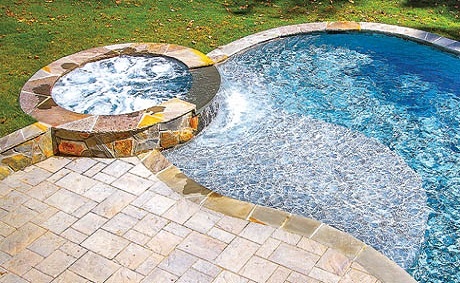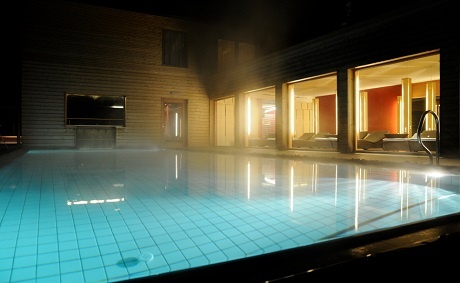Effective steps to prevent liquid losses from your backyard resort
Part 1 of a 2-part series on swimming pool water conservation

There’s good news for water-conscious swimming pool owners: Backyards with pools may actually be more water-efficient than those landscaped with lawns and sprinkler systems.
That’s right. According to a recent university study by the California Pool & Spa Association (CPSA), a typical pool and deck can use one-third less water per day than a new, well-irrigated grass lawn of comparable size.
This new information bodes well for pool owners everywhere who want to enjoy their liquid playground while being environmentally responsible. However, water conservation is still important for many pool owners, and there are effective strategies to help your pool more efficiently hold onto the water it has.
Evaporation: The #1 culprit of swimming pool water loss
Before learning about ways to preserve H2O in your pool, it’s important to understand the biggest challenge to doing so. Plain and simple, it comes down to evaporation. In fact, the Department of Energy suggests that evaporation is responsible for up to 70% of water loss in pools and spas.
Evaporation occurs when the pool surface is exposed to air and wind. The water molecules rise up from the top of the water, form into vapor, and escape into the atmosphere. Evaporation also occurs on cool nights, when a heated pool loses water volume as the water forms into mist in the chilly air
This is bad news for your pool: Depending on weather conditions like heat, wind, sunlight, and humidity, your water level can drop a quarter of an inch each day.
Fortunately, there are a number of ways to combat evaporation. Let’s look at how you can conserve as much water as possible in your pool. Pool owners may be surprised to learn that even after the sun goes down and the temperature drops, evaporation can strike!
Pool owners may be surprised to learn that even after the sun goes down and the temperature drops, evaporation can strike!
Note: Other factors can increase pool water consumption and loss, including leaks, splash out from boisterous water play, and water-intensive “backwash” cleaning of DE and sand filters. If present, these factors are important to research and address. This article is on saving water, but it focuses only on tactics to slow evaporation.
1. Cover your pool.
First and foremost: Use a pool cover! It’s the number-one tactic to conserve water. Covers can dramatically slow the pace that water evaporates—particularly on hot days and cold nights. Research shows that covering a pool can slash evaporation by a whopping 95%!
Not only are pool covers effective, they offer other benefits. Along with keeping more water in the pool, they keep more heat inside, reducing energy demands on your pool equipment. They also keep your pool cleaner, and depending on the type of cover, keep it safer as well.
With the wide array of models and price points available, a cover can work for most every pool and most every budget. You can invest thousands in a high-end automatic cover that extends across the pool with the push of a button. Or, you can drop about a hundred bucks for a lightweight solar blanket. These thin plastic blankets float on the pool surface and go onto the pool manually or with a reel.
Bonus tip: In some municipalities, water districts offer coupons or other incentives toward the purchase of a swimming pool solar blanket. Information about these offers—and sometimes an on-line coupon—is provided right on the water agency website.
The bottom line is that covers work really, really well. If you want to dramatically slow the march of evaporation on your pool-water level—and you do nothing else—adding a cover will make a world of difference.
2. Try a liquid solar blanket.
Don’t like the idea of using a solid cover or solar blanket on your pool? There’s an alternative. Although not effective as a genuine pool cover or solar blanket, a liquid solar blanket can provide some help.
Liquid blankets are lighter than water, and they are best described as a microscopic film that sits on the pool surface. They come in several forms, including tablets, bottles, and fish-shaped dispensers. They’re a snap to use. Simply pour or add the product into your pool, and the contents will automatically disperse across the entire pool.
Transforming into a protective molecular barrier, the liquid blanket traps heat and slows down evaporation. It’s biodegradable, invisible, and works 24/7 to help keep water from escaping your pool.
Used by thousands of pool owners, liquid blankets have increased in popularity over the last decade. Manufacturers point out that the product contents are safe, non-toxic for swimmers, and have zero effect on the water’s pH and chemical balance.
Some versions require you to manually add the product on a daily basis, while others provide automatic dispensers that work on their own for up to a month.
3. Turn off any water features.
Fountains, waterfalls, and laminar sprayers, as well pool slides with water flowing down their runways, add beauty, sound, and extra fun to your backyard resort. But when in use, they also increase the amount of water surface exposed to the air and sunlight. That extra exposure leads to extra evaporation.
In particular, pay extra attention to features that spray water into the air or that cascade in raindrop-style sheets of water. Because the entire surface of each small water droplets is exposed to air and heat, they are more prone to evaporation. Compared to a trickling rock waterfall, these kinds of features may lead to greater, quicker water loss.
Don’t make it so easy for extra water to escape your pool. Turn off these features to prevent needless evaporation; the added benefit will be saving energy that your pool pump requires to run them. Of course, when you entertain guests or when you and your family use the pool, turn them on, and enjoy!
4. Reduce water temperature.
Lowering the pool thermostat is a simple, effective way to slow evaporation. The reason: Warmer water has faster-moving molecules that more easily vaporize, and float away.
When the mercury drops in the evening, a warm pool becomes especially vulnerable; in the cold night air, water molecules turn into mist that easily evaporates. This process accelerates when the temperature of pool-water is higher than the temperature of the air.
Cooler water is more resistant to dispersing into the atmosphere. So take note: If you will not be using the pool for a while, just go ahead and turn down the heater. Ditto for the spa if you have one; the extra warm spa water is particularly susceptible to evaporation.
5. Add windbreaks.
Wind can speed up evaporation of pool water. To combat its effects, consider a windbreak—a barrier placed around your pool to curb the wind’s speed and ability to directly hit the water surface.
Not only will a strategically placed windbreak slow evaporation, it may prevent heavy gusts from creating waves and blowing some water out of your pool.
These barriers can take a couple of forms. Landscaping is one. For example, you can add a few rows of shrubs or some thick bushes. They will add beauty to your backyard while buffering some of the blowing wind around your pool.
Another form is a solid or semi-solid wood or metal fence. If you already have one that is not solid—such as a row, chain link, or wrought iron post—you may be able to alter it, creating an obstacle for the wind. To do so, consider placing certain kinds of material over the existing fence structure.
There are plenty of visually appealing options that can cover your fence to create virtual panels, including nets, tarps, screens or vinyl. Some can be custom designed with various colors or patterns to compliment your existing fence.
Another way to fortify your existing fence against the wind is with artificial hedges. These durable screens give the appearance of foliage like fern, ivy, and ficus. They have the added benefit of being affordable and easy to install. Along with hindering the wind’s impact on your pool water, this faux greenery will enhance your backyard privacy.
The takeaway: Minimize pool evaporation.
Unfortunately, natural evaporation causes pools everywhere to lose hundreds of gallons of water each year. For most homeowners, the single best path to water conservation is slowing this process so that pool refills are needed as infrequently as possible.
The key lies in keeping more of your water in the pool where it belongs. Now that you know what works to preserve it for as long as possible, take the right steps to reduce your pool’s liquid losses!




.jpg?width=1490&name=rock-waterfall-slide-pool%20(1).jpg)